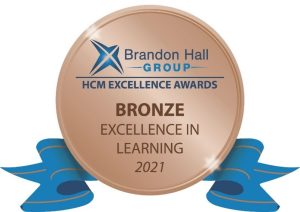Part 2 of 3
In part 1 we established the need for new thinking and new learning approaches in order to reach the ever-increasing number of remote learners in a flexible and impactful way.
The 3 core lenses through which we can evolve our learning approach.

Modularity
As the word suggests, modularity is about dividing up the learning assets into logical units of content – e.g., different topics. It can also be about breaking up different phases of learning – for example, moving from concept to case study to practice.
Modularity allows us to better configure our solutions to the needs of our learners. It also helps us to make the learning content more consumable over time.
For example, there is a lot of research that suggests that the so-called “spacing” of learning significantly improves the retention and proficiency of learners.
Delivery model
Today’s learner-needs require that we have more than one option. Whether it’s traditional classroom learning, virtual learning, eLearning or blended approaches, we need to give our learners flexibility and access.
The Learning Approach itself
All learners learn differently. We have also seen generational shifts in learning approaches. Ultimately, our approaches to learning need to be chosen very carefully to ensure people are engaged, based on who our target audience is.
They may include the more traditional systematic teaching, experiential learning or eLearning, for example.
With the Problem Solving Learning Path we are aiming to hit all 3: modularity, providing easy access, and a mix of systematic teaching and gamification.
What learners will learn
In today’s world of increasing complexity and, of course, less time – problem solving skills are at a premium.
However, in many organizations, that don’t have a common problem-solving approach, what we often find is a lot of trial-and-error leading to wasted time and effort.

The Problem Solving Learning Path provides a foundational understanding of the KT methodologies of Situation Appraisal and Problem Analysis.
While Situation Appraisal is about getting clarity about the issues we’re dealing with, prioritizing them and planning their resolution, Problem Analysis is about finding the cause of a problem and fixing it for good.
If you think about it in the form of a workflow, in an organization that has a common problem-solving approach you will see much more of a flow. Flow means we are following a common, integrated logic that connects people in a team and an organization. This makes the Problem Solving Learning Path a powerful foundation for creating an organization-wide problem-solving capability.
But learning these thinking processes isn’t as simple as looking at a diagram and then being able to go use them on the job to create tangible business results. So, the challenge for our learning designers was to break things down into small enough chunks so that learners could understand them even if they had only a few minutes each time they were able to learn. Then they needed to give learners opportunities to both practice individual concepts and use them in combination. Finally, they needed to provide opportunities to use the concepts to address real-world situations and problems.
The learning cycles described in part 1 of this series represent single concepts, so threading them together in a logical order helps learners to build their understanding one step at a time, as well as see how the concepts work together. Adding a reinforcement cycle every couple of modules provides the needed practice, and regularly promotes the application of each step on an actual business-related issue.

The practice in the reinforcement cycle is a bit different than practice in the basic learning cycle.
Learners are presented with a threaded scenario and they are asked to use the steps they just learned to move the analysis forward. For example, if they’ve already gathered and organized data for a problem and identified some possible causes, they are next asked to test each possible cause fully, using the organized data to rule them in or out.

Because learners cement their learning by ‘doing’, KT Learning Path learners complete the reinforcement cycle by applying the steps they have just practiced on their own issue. They are prompted with appropriate tools – job aids, worksheets, tips and hints – related to the steps they are using and reminded to share their work with the coach working with their cohort.

Altogether, the combination of initial and reinforcing learning cycles creates a dynamic way for learners to more fully understand the concepts of Situation Appraisal and Problem Analysis, taking into account their need for flexibility and best-practices in virtual adult learning.

Even with all of that, there is still more to the KT Problem Solving Learning Path design. In the final edition of this blog (part 3 of 3), we will focus on the role coaching plays, even in virtual learning, to maximize these business results.
Brandon Hall Award for Excellence in Learning
We are excited that we can now offer the Problem Solving Learning Path to the wider market. We are also excited, as we recently announced, that Microsoft and KT received a Brandon Hall Award for our overall KT program in a year where there has been a record amount of innovation.

If the information in this blog piqued your interest, you can get more information about the KT Problem Solving Learning Path here
About Kepner-Tregoe
Founded in 1958, and based on ground-breaking research regarding how people think, solve problems and make decisions, Kepner-Tregoe provides a unique combination of training and consulting services to improve quality and effectiveness while reducing overall costs. The KT methodology is used at every level of client organizations: to implement strategy, achieve continuous improvement, increase customer satisfaction, and drive effective issue resolution throughout the organization.







